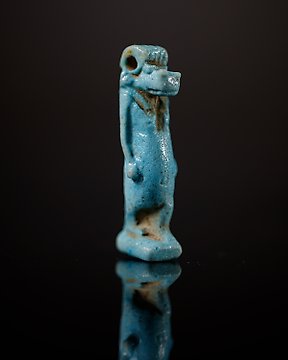
Ókori egyiptomi Isten amulettje, Taweret - 4.8 cm
Nr. 83275919

Nr. 83275919

God Ptah
- Nice Piece! -
Ancient Egypt
PERIOD: Late Period, 664 - 332 BC
MATERIAL: Bronze
DIMENSIONS: 8 cm height. 9.5 cm height with the stand.
PROVENANCE: Private collection, Paris, France. Purchased from Hôtel Drouot, Maître Maignan, October 10, 1973, lot 62.
DOCUMENTATION: - Adjunta factura del Hôtel Drouot, Maître Maignan, 10 de octubre de 1973, lote 62.
CONDITION: Intact.
DESCRIPTION:
A solid bronze sculpture representing the Egyptian deity Ptah. He is wearing a shroud from head to foot which closely hugs his body. The arms are outlined but the hands alone are visible. An usekh, or wide collar, circles his neck. Usekhs are typical accessories of Egyptian deities and nobility. The most commonly used typology is made up of various rows of beads. The head is totally covered by a smooth, tightly-fitting helmet, characteristic of this god, and also used by priests. He is the only god, moreover, who has a straight beard, as the one normally seen is curved upward at the end. These two attributes are those associated with Ptah.
The hands of the god, holding a was sceptre, the symbol of authority and power, project from two vertical openings in the shroud. The sceptre is a straight rod with the lower end in the form of a hook and the upper end showing some sort of fabulous animal which cannot for the moment be identified.
Although Ptah is not one of the most famous gods, he is one of the most important in the Egyptian pantheon. His name may mean “the Creator”. He was the sovereign of all the gods as he created the universe through “Thought”. He is also known by other epithets such as the “Lord of Magic”, the “Lord of Darkness” and the “Lord of Truth”. He was originally associated with Memphis, the capital of the Old Kingdom. From the time of the New Kingdom, he formed part of a triad with his wife, Sekhmet, and his son, Nefertem. He was also a funerary god: in pictorial depictions he appears with a green face, a sign that he is a god of the Afterlife, just like Osiris.
One of the most important functions of Ptah was as the patron of craftsmen, above all, of sculptors and metal craftsmen. He was considered to be the inventor of manual practices and techniques, and was worshipped in the town well-known for its craftsmen, Deir el-Medina. The working of jewellery was usually done by dwarfs, and these were under the protection of Ptah and his sons, the Pataikos.
This statuette of Ptah was made using the lost wax technique, a technique in sculpture where a mould is first made from a prototype traditionally sculpted in beeswax. This is covered by a thick layer of soft material, usually clay, which solidifies. Once this is done it is fired in an oven where the wax melts and comes out of the mould through specially made perforations. Molten metal is then injected into the mould and takes on its exact form. To release the final piece the mould must be removed.
PARALLELS:
- Figure of the god Ptah. Bronze. Dynasty XXVI 664–525 BC. Dallas Museum of Art. University of Pennsylvania Museum (USA). E14294.
BIBLIOGRAPHY:
- SILVERMAN, D. Searching for Ancient Egypt: Art, Architecture and Artefacts from the University of Pennsylvania Museum. Pennsylvania University Press. 1997. Fig. 3.
- WILKINSON H. R. The Complete Gods and Goddesses of Ancient Egypt. London. 2003.
Notes:
The seller guarantees that he acquired this piece according to all national and international laws related to the ownership of cultural property. Provenance statement seen by Catawiki.
The seller will take care that any necessary permits, like an export license will be arranged, he will inform the buyer about the status of it if this takes more than a few days.
The piece includes authenticity certificate.
The piece includes Spanish Export License.
Hogyan vásárolhatok a Catawiki-n?
1. Fedezzen fel valami különlegeset
2. Tegye meg a legmagasabb licitet
3. Fizessen a biztonságos és védett rendszert használva